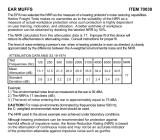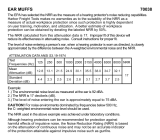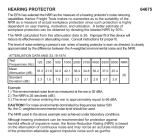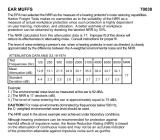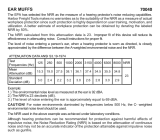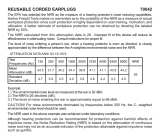Page is loading ...

because we all are different
LOGOL2NEGPDF
1

5
DESCRIPTION
These ear muffs are equipped with an integrated AM/FM radio receiver. The sound reproduction is limited to a
maximum of 82 dB (A) to prevent hearing damage. To ensure you get the best comfort, fit and function from the
product, read the instructions carefully and save them for future reference.
These earmuffs are designed to reduce exposure to harmful levels of noise. Refer to the attenuation data tables
for details on noise reduction. Make sure you have selected the correct product for your application.
USER INSTRUCTIONS
Refer to corresponding illustrations at beginning of this instruction manual.
Battery Installation/Replacement (Illustration E)
The product must be equipped with two standard alkaline batteries 1.5V AA/LR6.
The battery compartment is located in the left cup. Remove the lid (E1) and insert the batteries. Make sure that
the + and – poles are correctly aligned (E2). Replace the lid.
Note: Rechargeable batteries type NiMH 1.2V or NiCd 1.2V should not be used because they will considerably
reduce operating time.
Battery Disposal
Batteries must be disposed of in accordance with all applicable federal, state and local regulations.
Operation (Illustration F)
• To turn radio ON, set the frequency band selector (F1) to AM or FM.
• To turn radio OFF, set the switch (F1) to OFF.
• To select a radio station, rotate the tuning knob (F2).
• Adjust the volume knob (F3).
IMPORTANT INFORMATION ABOUT RADIO RECEPTION
The quality of radio reception varies considerably due to many circumstances, e.g., distance from the transmitter
antenna, topography, natural surroundings, buildings, screening materials and electrical interference.
FITTING INSTRUCTIONS
Refer to corresponding illustrations at beginning of this instruction manual.
CAUTION
Spread the ear cups only enough to clear the ears.
Do not reform or reshape the headband.
Foreign objects (such as pencils) between the ear cup and wearer’s head reduce the efciency of the ear
muff. Remove as much hair as possible.
Use glasses with smallest temple available (cable type is best).
Headband version (Illustration A):
A 1: The inside of the headband is marked with a letter L above the left cup and a letter R above the right cup.
Ensure that the headband is positioned correctly, with the left cup on the left ear and the right cup on the right ear.
A 2: With the headband over the head, adjust the height of the cups by sliding them up or down so they comple-
tely enclose the ears.
Helmet attachment (Illustration B):
B1: Left and Right cups. The earmuff marked with the letter L must be attached to the left side of the helmet, and
the earmuff marked with the letter R must be attached to the right side of the helmet.
CAUTION!
If the helmet is worn in reverse (with the brim to the rear), the muffs must be worn on the right and left ears
as marked. Failure to do so may result in a reduction of attenuation.
B 2-3: Fitting the cups. Pull the ear cup down to the bottom of the yolk and lift the blade until the spring clicks up.
Push the attachment blade firmly into the slot on the side of the helmet until it clicks into place.
B 4: Working Position. Adjust the cups until they are comfortable. Make sure that the cushions seal tightly around
the ears.
USA / CAN / MX

6
CAUTION!
In noisy environments, the earmuffs must be worn in the working position at all times.
B 5: Stand-by position. Pull the ear-muff away from the ear until it locks into the stand-by position.
B 6: Parked Position. First lift the cups to the stand-by position, and then rotate them back to the next fixed
position. In this position, the cushion does not get damaged or dirty and the cups can dry out on the inside.
NOTE: Do not press the cups onto the helmet shell as this will lock the spring in the ear-muff arm and damage the
attachment slots on the side of the helmet.
B 7: Storage Position. When the helmet is not in use, lower the ear-muffs and press them inward.
Note: These helmet-mounted hearing protectors are only approved for use with MSA slotted caps.
STORAGE
When the hearing protector is not in use, store it in such a way that the headband is not stretched and the
cushions are not compressed. Keep the ear-muffs dry and clean, store them at normal room temperature and do
not place them in direct sunlight.
CAUTION!
If storage recommendations are not followed, the protection afforded by the hearing protector may be
severely impaired.
MAINTENANCE
Clean and disinfect the cups, cushions and inserts with mild soap and water only. Ear muffs and cushions in
particular may deteriorate with use. Examine at frequent intervals for cracking and leakage, for example at the
start of every working shift. Replace damaged or worn ear muffs or cushions.
HYGIENE KITS The cushions and inserts are replaceable. Always replace worn or damaged parts. Remove the
cushion by pulling it straight out (refer to illustration C1 at beginning of this instruction manual). Replace the old
cushion and insert with new ones from the hygiene kit (refer to illustration C2 at beginning of this instruction
manual). If the ear muff is used regularly, replace the hygiene kit at least twice a year to ensure that the noise
attenuation performance is maintained.
Note: Use only hygiene kits (cushions and inserts) from MSA.
left/RIGHT ™ Ear Muff Order Kit #
MEDIUM 10094605
WARRANTY
The product is guaranteed for one year from date of purchase against defects in material or workmanship. This
guarantee does not extend to damage caused by product misuse, abuse or unauthorized modifications. To make a
claim, please contact the source of purchase.
TESTING AND APPROVALS
The Noise Reduction Rating (NRR) is third-party certified in accordance with ANSI S3.19-1974. It also meets CSA
Class A.
Use Limitations
The level of noise entering a person’s ear, when hearing protection is worn as directed, is closely approximated by
the difference between the A-weighted environmental noise level and the NRR.
Example: The environmental noise level as measured at the ear is 92 dB(A). The NRR is (24) decibels (dB). The
level of noise entering the ear is approximately equal to 68dB(A) [92 – 24 dB(A)].
CAUTION!
For noise environments dominated by frequencies below 500 Hz the C-weighted environmental noise level
should be used.
The EPA has selected the NRR as a measure of a hearing protector’s noise reducing capabilities. There is no
warranty as to the suitability of the NRR as a measure of the actual workplace protection since such protection is
USA / CAN / MX

7
highly dependent on user training, motivation, and utilization. Refer to the above instructions for proper fit.
Although hearing protectors can be recommended for protection against the harmful effects of impulsive noise,
the Noise Reduction Rating (NRR) is based on the attenuation of continuous noise and may not be an accurate
indicator of the protection attainable against impulsive noise such as gunfire.
The noise reduction capability of this hearing protector against impulsive noise may be estimated by referring to
the attenuation performance of the hearing protector at the frequency of the impulsive noise exposure as provided
in the attenuation data on the package.
To estimate the noise reduction capability of this hearing protector against impulsive noise, refer to the At-
tenuation Data below or on the product package. If the frequency of the impulsive noise is 2000 hertz (Hz), for
example, the mean (average) reduction of noise attained by test subjects at that frequency was 32.1 decibels (dB).
Using the standard deviation of + 2.8 dB, the estimated noise reduction at 2000 Hz would range from 29.3 dB to
34.9 dB.
Refer to manufacturer of equipment producing the impulsive noise to determine the frequency.
WARNING!
An appropriate hearing conservation program must be utilized that includes adequate monitoring and
audiometric testing to ensure effective hearing protection. Improper use of the hearing protector or failure to
conduct adequate monitoring and testing can result in hearing loss or other serious personal injury.
ATTENUATION DATA
ANSI S3.19-1974
Warning!
For noise environments dominated by frequencies below 500 Hz, the C-weighted environmental noise level
should be used. Improper fit of this device will reduce its effectiveness in attenuating noise. Failure to follow
this warning can result in serious personal injury or permanent hearing loss.
MSA Corporate Headquarters
P.O. Box 426
Pittsburgh, PA 15230
USA
Phone 412.967.3000
U.S. Customer Service 1.800.MSA.2222
MSA Canada 416.520.4225
MSA Mexico (52) 55 2122 5770
MSA International 412.967.3354
www.MSAnet.com
ATTENUATION DATA - headband version
MEDIUM
Frequency (Hz) 125 250 500 1000 2000 3150 4000 6300 8000 NRR
Mean (dB) 15.8 20.0 27.4 30.7 32.1 37.9 39.2 41.2 38.8
23
Standard deviation (dB) 2.8 2.5 3.0 2.4 2.8 3.1 3.2 2.8 3.7
+
T
U
N
E
-
+
V
O
L
-
FM
OFF
(AM)
C 3
FM knob sidvy hjäss
R
FM knob sidvy med hjälm
L
R
OFF
FM
FM knob hel kåpa märkt L/R
(AM)
+
+
+
+
C 4
USA / CAN / MX

16
www.left-right.eu
SD07231003
/
